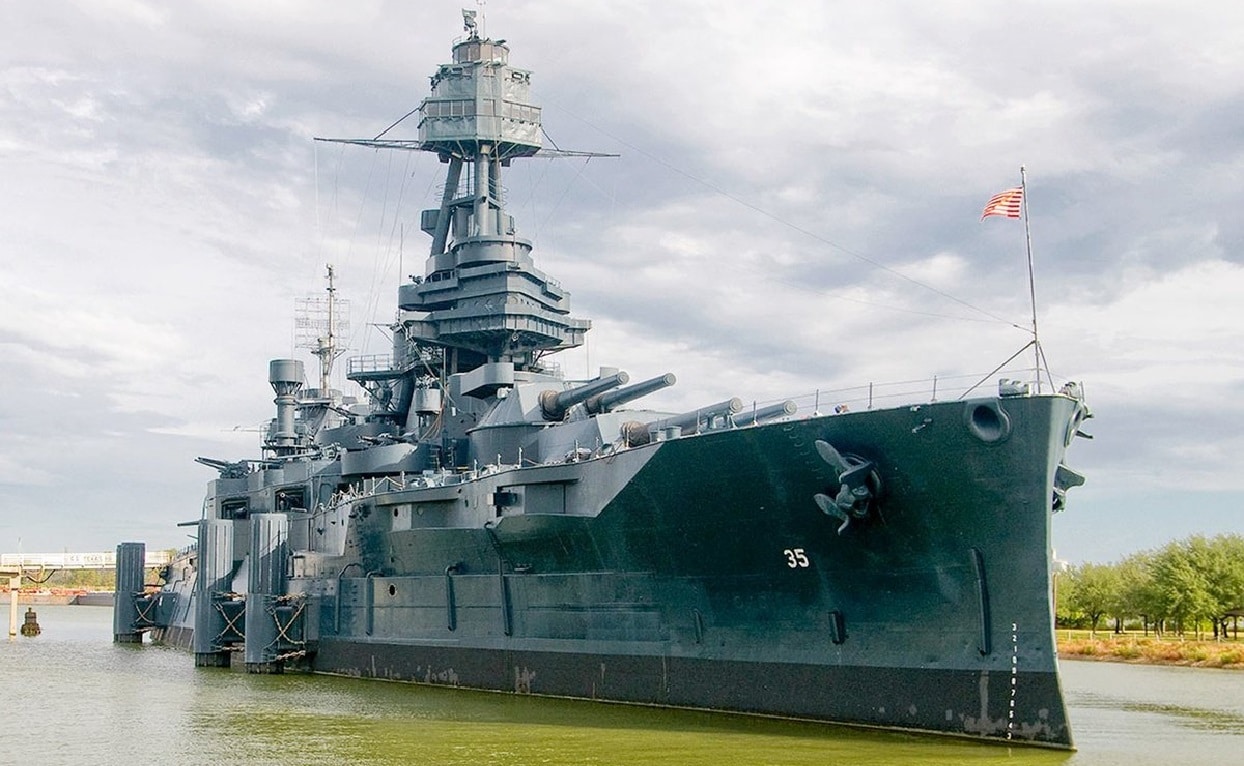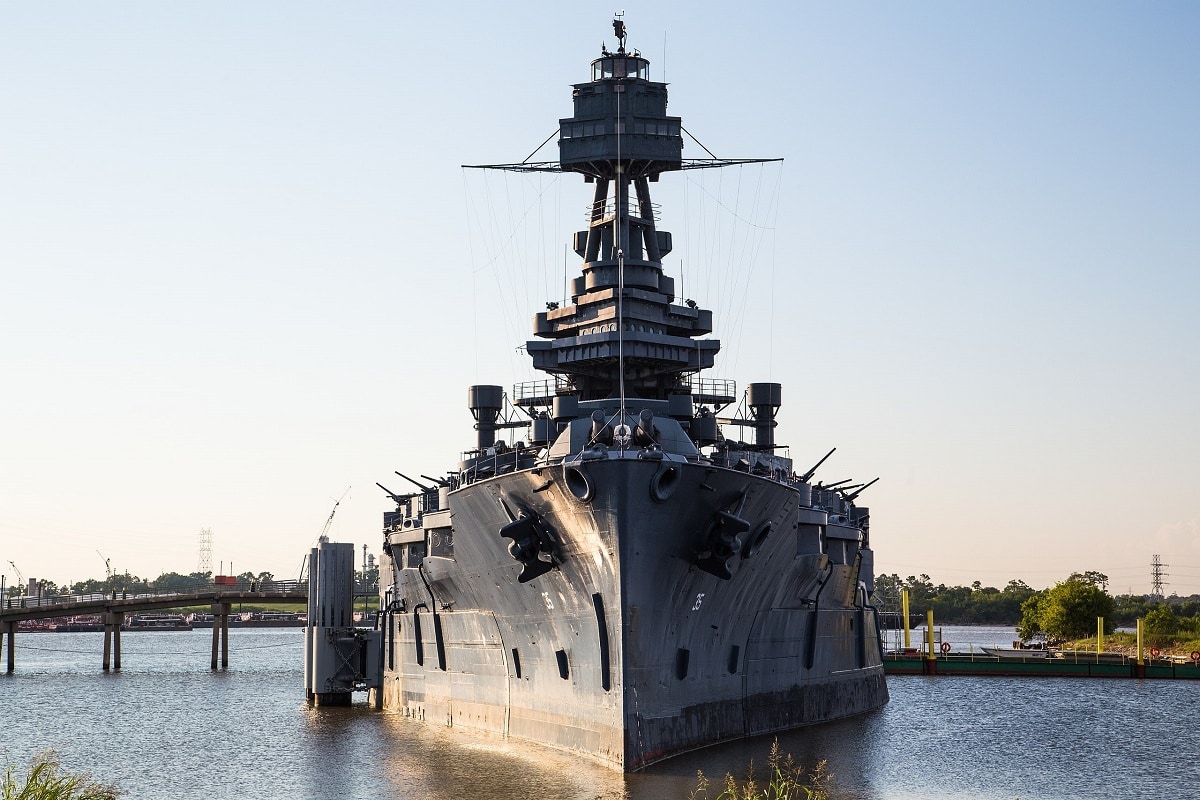Article Summary: The USS Texas (BB-35), a historic battleship that served in both World Wars, faces an uncertain future. After a $75 million restoration, the ship is fully repaired but has no permanent home.
Key Point #1 – Originally docked at the San Jacinto Battleground, its old slip has been closed, leaving officials scrambling to find a new location. Galveston business owners oppose keeping the ship, calling it an eyesore, while Corpus Christi has been floated as a possible destination.
Key Point #2 – As time runs out, Texans and historians alike wonder: where will the last surviving dreadnought from both world wars finally drop anchor?
Why Hasn’t Battleship USS Texas Found a Permanent Home?
The USS Texas (BB-35) was completed in 1914, right around when World War I started. The USS Texas and her sister ship, the USS New York (BB-34), were the first US battleships designed to carry 14-inch (356mm/45-caliber) guns.
The Texas is the only battleship still in existence today that served in World Wars I and II. But after serving her country in two World Wars, she was retired and has served as a museum ship since 1948, as the flagship of “the Texas Navy.”
She spent 70 years in the Houston Channel near the San Jacinto Battleground, where Texas won its independence from Mexico.
Now, the proud ship is a battleship without a home.
Background on the USS Texas (BB-35)
The USS Texas took part in the “Tampico Incident,” which involved the United States’ occupation of Vera Cruz, straining relations between the US and Mexico. She then began fleet operations after America entered the First World War in 1917. She didn’t fire her guns during the war.
Two 4-cylinder Vertical Triple Expansion engines powered the USS Texas, and 14 Babcock & Wilcox coal-fired boilers could provide more than 28,000 horsepower. The ship could reach 21 knots and had a range greater than 7,000 nautical miles.
During the post-war years, from September 1927 to September 1931, Texas became the flagship of the United States Fleet, one of only four ships to be designated U.S. Fleet flagships from 1922 to 1941.
Technological Test Bed Ship
The USS Texas was also a perfect technological testbed for the Navy. It was the first US battleship to mount anti-aircraft guns and the first US warship to control gunfire with directors and rangekeepers.
In March 1919, she became the first US battleship to launch a British Sopwith Camel aircraft from a temporary platform fitted atop her number 2 turret. She was one of the first US Navy warships to receive production radar.
Her ten 14-inch guns could fire 1,400 lb (635 kg) armor-piercing shells for 13 mi (11 nmi; 21 km). Her secondary battery consisted of twenty-one 5-inch (127 mm)/51-caliber guns. Texas also mounted four 21-inch (533 mm) torpedo tubes for the Bliss-Leavitt Mark 8 torpedo, one each on the port-side bow and stern and starboard bow and stern. The torpedo rooms held 12 torpedoes total, plus 12 naval defense mines.
For her day, she packed quite a punch.
World War II and Retirement
After the bombing of Pearl Harbor, the Texas was in Casco Bay, Maine on R&R, and was ordered to convoy duty. She took part in the first amphibious landing in the Atlantic when she supported “Operation Torch,” the invasion of North Africa. A young Walter Cronkite was onboard the Texas during the battle.
The USS Texas was part of the massive fleet to sail for “D-Day,” the invasion of France on June 6, 1944. She bombarded the French coast at Pointe du Hoc and the town of Cherbourg and was struck by coastal artillery fire but suffered minor damage.
After being repaired and reassembled in England, the USS Texas participated in the Southern France landing “Operation Dragoon” near the French Riveria. Heavy resistance was expected, but the Germans were surprised, and the troops raced inland. She returned to New York and had her main gun barrels replaced.
From there, the Texas sailed through the Panama Canal. After spending Christmas 1944 in Pearl Harbor, she sailed for the Marianas. There, she participated in the naval bombardment of Iwo Jima and Okinawa.
During the two-month campaign in Okinawa, the crew of the Texas remained at general quarters for seven weeks due to the kamikaze threat. For meals, they ate only crackers and K-rations, and their only resting time was a quick shower and change of clothes every three days.
After Japan surrendered, the USS Texas shuttled troops home as part of Operation Magic Carpet. In June 1946, she was inactivated, and the state of Texas planned to tow the ship back to Houston. In 1948, the USS Texas became the first permanent battleship museum in the US.
Problems Arise Through The Years
The old battlewagon developed a large leak that threatened to sink the ship. She is currently undergoing a $75 million restoration at the Gulf Cooper Shipyard in Galveston, Texas. She is now nearly brand new, and the restoration should be complete later this year.
But there is a problem. Her old slip at San Jacinto has closed and won’t reopen. The city of Galveston’s high-dollar restauranteurs want the ship gone, stating that the old girl is an eyesore and ruins the views from their establishments.

USS Texas battleship. Image: Creative Commons.
The battleship, which the Texas Parks and Wildlife Department owns with the foundation holding a 99-year lease to operate it as a museum ship, “could be [placed] anywhere on port property,” said Victor Pierson, the USS Texas trustees’ board chairman.
No one knows where the old battlewagon will end up. Some say it will be in Corpus Christi next to the old aircraft carrier Lexington, but nothing is sure yet. The people of Texas and the battleship need their namesake, given its rightful place of honor.
“Git er done.”

Battleship USS Texas. Image: Creative Commons.
About the Author
Steve Balestrieri is a 19FortyFive National Security Columnist. He served as a US Army Special Forces NCO and Warrant Officer. In addition to writing for 19FortyFive, he covers the NFL for PatsFans.com and is a member of the Pro Football Writers of America (PFWA). His work was regularly featured in many military publications.

